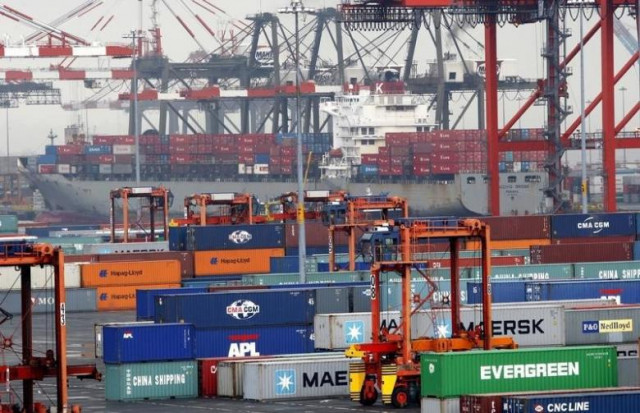Pakistan’s exports to China will rise in second phase of FTA
Commerce secretary emphasises equitable distribution of free trade benefits

Shipping containers are seen at the Port Newark Container Terminal. PHOTO: REUTERS
“In the next five years, China will import products worth $8 trillion and once the second phase of our FTA is concluded and implemented, Pakistan will be able to expand its exports to China due to low tariff rates. In addition, Pakistan will also be able to attract more investment from China,” he said. He was speaking at the opening session of the eighth meeting of the second phase of FTA negotiations held at the Chinese Ministry of Commerce.
Pakistan, Thailand: FTA discussions to enter crucial stage
He said China was a huge market and home to 1.3 billion people and its domestic consumption was booming, adding economic and trade cooperation was the anchor and propeller of relations between China and Pakistan.
“In recent years, our cooperation has developed remarkably and benefited many enterprises and people in both the countries,” he added.
Terming CPFTA one of the earnest FTAs of China, he said it had played a significant role in promoting Sino-Pakistan cooperation and made China Pakistan’s largest trading partner.
He was of the view that the first phase of the FTA had given a lot of impetus to the economic and trade ties.
“However, with the trade liberalisation level of only 36%, there is still a huge space for both sides to raise the current level,” he said. “I believe a relatively high level of liberalisation will promote common development and provide benefits for more people of our countries.”
The vice minister said the leadership of the two countries attached great importance to the FTA negotiations. A statement of Chinese President Xi Jinping during his visit to Pakistan in April 2015 clearly pointed out that both sides had decided to speed up negotiations on the second phase of FTA, he added.
While reciprocating the warm feelings of the Chinese official, Federal Commerce Secretary Younus Dagha said, “China is now Pakistan’s major trading partner with volume of trade reaching an all-time high at $16 billion in 2016-17 from $4 billion in 2006-07.”
“However, keeping in view the respective sizes of the two economies, the gains for both sides should be equal,” he emphasised. Following the FTA, Pakistan’s trade deficit with China has widened markedly, surging from $2.9 billion in 2006-07 to $12.7 billion in 2016-17. Last year, Pakistan’s global imports grew 18.5% while exports edged down 1.6%.
FTA with China: a loss-making deal for Pakistan
He said imports from China alone accounted for 36% of Pakistan’s global non-oil imports.
Dagha underlined the need for sending positive signals to the people of both countries that benefits of the China-Pakistan Economic Corridor (CPEC) and CPFTA would be shared equitably and that the economy of Pakistan would be a major beneficiary.
Published in The Express Tribune, September 15th, 2017.
Like Business on Facebook, follow @TribuneBiz on Twitter to stay informed and join in the conversation.



















COMMENTS
Comments are moderated and generally will be posted if they are on-topic and not abusive.
For more information, please see our Comments FAQ